Physicochemical Characterization of Thirteen Quinoa (Chenopodium quinoa Willd.) Varieties Grown in North-West Europe—Part II
Abstract
:1. Introduction
2. Results and Discussion
2.1. Chemical Composition
2.2. Physicochemical Properties
2.2.1. Water Absorption Capacity
2.2.2. Water Absorption Index
2.2.3. Pasting Properties
2.3. Principal Components Analysis and Hierarchical Cluster Analysis
3. Material and Methods
3.1. Quinoa Wholemeal Flours
3.2. Chemical Composition
3.3. Physicochemical Properties
3.4. Statistical Analysis
4. Conclusions
Supplementary Materials
Author Contributions
Funding
Data Availability Statement
Acknowledgments
Conflicts of Interest
References
- Solaesa, Á.G.; Villanueva, M.; Vela, A.J.; Ronda, F. Protein and lipid enrichment of quinoa (cv.Titicaca) by dry fractionation. Techno-functional, thermal and rheological properties of milling fractions. Food Hydrocoll. 2020, 105, 105770. [Google Scholar] [CrossRef]
- Aluwi, N.A.; Murphy, K.M.; Ganjyal, G.M. Physicochemical characterization of different varieties of quinoa. Cereal Chem. 2017, 94, 847–856. [Google Scholar] [CrossRef]
- Nowak, V.; Du, J.; Charrondière, U.R. Assessment of the nutritional composition of quinoa (Chenopodium quinoa Willd.). Food Chem. 2016, 193, 47–54. [Google Scholar] [CrossRef]
- Escribano, J.; Cabanes, J.; Jiménez-Atiénzar, M.; Ibañez-Tremolada, M.; Gómez-Pando, L.R.; García-Carmona, F.; Gandía-Herrero, F. Characterization of betalains, saponins and antioxidant power in differently colored quinoa (Chenopodium quinoa) varieties. Food Chem. 2017, 234, 285–294. [Google Scholar] [CrossRef] [PubMed]
- Vilcacundo, R.; Hernández-Ledesma, B. Nutritional and biological value of quinoa (Chenopodium quinoa Willd.). Curr. Opin. Food Sci. 2017, 14, 1–6. [Google Scholar] [CrossRef] [Green Version]
- Sobota, A.; Świeca, M.; Gęsiński, K.; Wirkijowska, A.; Bochnak, J. Yellow-coated quinoa (Chenopodium quinoa Willd)—physicochemical, nutritional, and antioxidant properties. J. Sci. Food Agric. 2020, 100, 2035–2042. [Google Scholar] [CrossRef] [PubMed]
- Bhargava, A.; Srivastava, S. Quinoa: Botany, production and uses; CABI: Wallingford, UK, 2013; ISBN 1780642261. [Google Scholar]
- Präger, A.; Munz, S.; Nkebiwe, P.M.; Mast, B.; Graeff-Hönninger, S. Yield and quality characteristics of different quinoa (Chenopodium quinoa willd.) cultivars grown under field conditions in southwestern Germany. Agronomy 2018, 8, 197. [Google Scholar] [CrossRef] [Green Version]
- Li, G.; Zhu, F. Physicochemical properties of quinoa flour as affected by starch interactions. Food Chem. 2017, 221, 1560–1568. [Google Scholar] [CrossRef] [PubMed]
- Bhargava, A.; Ohri, D. Origin of genetic variability and improvement of quinoa (Chenopodium quinoa Willd.). In Gene Pool Diversity and Crop Improvement; Springer: Berlin/Heidelberg, Germany, 2016; pp. 241–270. [Google Scholar]
- Li, G.; Wang, S.; Zhu, F. Physicochemical properties of quinoa starch. Carbohydr. Polym. 2016, 137, 328–338. [Google Scholar] [CrossRef]
- Contreras-Jiménez, B.; Torres-Vargas, O.L.; Rodríguez-García, M.E. Physicochemical characterization of quinoa (Chenopodium quinoa) flour and isolated starch. Food Chem. 2019, 298, 124982. [Google Scholar] [CrossRef]
- Lindeboom, N. Studies on the Characterization, Biosynthesis and Isolation of Starch and Protein from Quinoa (Chenopodium quinoa Willd.). Ph.D. Thesis, University of Saskatchewan, Saskatoon, SK, Canada, 2005. [Google Scholar]
- Filho, A.M.M.; Pirozi, M.R.; Borges, J.T.D.S.; Pinheiro Sant’Ana, H.M.; Chaves, J.B.P.; Coimbra, J.S.D.R. Quinoa: Nutritional, functional, and antinutritional aspects. Crit. Rev. Food Sci. Nutr. 2017, 57, 1618–1630. [Google Scholar] [CrossRef]
- Bhargava, A.; Shukla, S.; Ohri, D. Chenopodium quinoa—An Indian perspective. Ind. Crops Prod. 2006, 23, 73–87. [Google Scholar] [CrossRef]
- Pineli, L.L.O.; Botelho, R.B.A.; Zandonadi, R.P.; Solorzano, J.L.; de Oliveira, G.T.; Reis, C.E.G.; Teixeira, D. da S. Low glycemic index and increased protein content in a novel quinoa milk. LWT—Food Sci. Technol. 2015, 63, 1261–1267. [Google Scholar] [CrossRef]
- Ghumman, A.; Mudgal, S.; Singh, N.; Ranjan, B.; Kaur, A.; Rana, J.C. Physicochemical, functional and structural characteristics of grains, flour and protein isolates of Indian quinoa lines. Food Res. Int. 2021, 140, 109982. [Google Scholar] [CrossRef] [PubMed]
- Jacobsen, S.E. The scope for adaptation of quinoa in Northern Latitudes of Europe. J. Agron. Crop Sci. 2017, 203, 603–613. [Google Scholar] [CrossRef]
- De Bock, P.; Van Bockstaele, F.; Muylle, H.; Quataert, P.; Vermeir, P.; Eeckhout, M.; Cnops, G. Yield and Nutritional Characterization of Thirteen Quinoa (Chenopodium quinoa Willd.) Varieties Grown in North-West Europe—Part I. Plants 2021, 10, 2689. [Google Scholar] [CrossRef]
- De Bock, P.; Daelemans, L.; Selis, L.; Raes, K.; Vermeir, P.; Eeckhout, M.; Van Bockstaele, F. Comparison of the chemical and technological characteristics of wholemeal flours obtained from amaranth (Amaranthus sp.), quinoa (chenopodium quinoa) and buckwheat (fagopyrum sp.) seeds. Foods 2021, 10, 651. [Google Scholar] [CrossRef]
- Vázquez-Luna, A.; Fuentes, F.; Rivadeneyra, E.; Hernández, C.; Díaz-Sobac, R. Nutrimental content and functional properties of Quinoa flour from Chile and Mexico. Cienc. Investig. Agrar. 2019, 46, 144–153. [Google Scholar] [CrossRef]
- Coțovanu, I.; Batariuc, A.; Mironeasa, S. Characterization of quinoa seeds milling fractions and their effect on the rheological properties of wheat flour dough. Appl. Sci. 2020, 10, 7225. [Google Scholar] [CrossRef]
- Tafadzwa, M.J.; Zvamaziva, J.T.; Charles, M.; Amiel, M.; Pepukai, M.; Shepherd, M. Proximate, physico-chemical, functional and sensory properties of quinoa and amaranth flour AS potential binders in beef sausages. Food Chem. 2021, 365, 130619. [Google Scholar] [CrossRef]
- Srichuwong, S.; Curti, D.; Austin, S.; King, R.; Lamothe, L.; Gloria-Hernandez, H. Physicochemical properties and starch digestibility of whole grain sorghums, millet, quinoa and amaranth flours, as affected by starch and non-starch constituents. Food Chem. 2017, 233, 1–10. [Google Scholar] [CrossRef]
- Ahmed, J.; Thomas, L.; Arfat, Y.A. Functional, rheological, microstructural and antioxidant properties of quinoa flour in dispersions as influenced by particle size. Food Res. Int. 2019, 116, 302–311. [Google Scholar] [CrossRef]
- Rulahnia, K.; Khatkar, B.S. Isolation and Characterization of Starch from Quinoa (Chenopodium Quinoa Willd.). Int. J. Innov. Res. Adv. Stud. 2020, 7, 1–6. [Google Scholar]
- Tiga, B.H.; Kumcuoglu, S.; Vatansever, M.; Tavman, S. Thermal and pasting properties of Quinoa—Wheat flour blends and their effects on production of extruded instant noodles. J. Cereal Sci. 2021, 97, 103120. [Google Scholar] [CrossRef]
- Steffolani, M.E.; León, A.E.; Pérez, G.T. Study of the physicochemical and functional characterization of quinoa and kañiwa starches. Starch/Staerke 2013, 65, 976–983. [Google Scholar] [CrossRef]
- Opazo-Navarrete, M.; Tagle Freire, D.; Boom, R.M.; Janssen, A.E.M.; Schutyser, M.A.I. Dry fractionation of quinoa sweet varieties Atlas and Riobamba for sustainable production of protein and starch fractions. J. Food Compos. Anal. 2018, 74, 95–101. [Google Scholar] [CrossRef]
- Horstmann, S.W.; Belz, M.C.E.; Heitmann, M.; Zannini, E.; Arendt, E.K. Fundamental Study on the Impact of Gluten-Free Starches on the Quality of Gluten-Free Model Breads. Foods 2016, 5, 30. [Google Scholar] [CrossRef] [Green Version]
- Barak, S.; Mudgil, D.; Khatkar, B.S. Relationship of gliadin and glutenin proteins with dough rheology, flour pasting and bread making performance of wheat varieties. LWT-Food Sci. Technol. 2013, 51, 211–217. [Google Scholar] [CrossRef]
- Kaur, A.; Singh, N.; Ezekiel, R.; Guraya, H.S. Physicochemical, thermal and pasting properties of starches separated from different potato cultivars grown at different locations. Food Chem. 2007, 101, 643–651. [Google Scholar] [CrossRef]
- Dziki, D.; Laskowski, J. Influence of kernel size on grinding process of wheat at respective grinding stages. Polish J. food Nutr. Sci. 2004, 54, 29–33. [Google Scholar]
- Singh, J.; Singh, N. Studies on the morphological, thermal and rheological properties of starch separated from some Indian potato cultivars. Food Chem. 2001, 75, 67–77. [Google Scholar] [CrossRef]
- Wu, G.; Morris, C.F.; Murphy, K.M. Evaluation of texture differences among varieties of cooked Quinoa. J. Food Sci. 2014, 79, S2337–S2345. [Google Scholar] [CrossRef]
- Englyst, H.N.; Kingman, S.M.; Cummings, J.H. Classification and measurement of nutritionally important starch fractions. Eur. J. Clin. Nutr. 1992, 46, S33–S50. [Google Scholar] [CrossRef]
- FAO Energy and Protein Requirements; Rome, 1973. Available online: https://www.fao.org/3/m2995e/m2995e00.htm (accessed on 28 August 2021).
- Hellemans, T.; Abera, G.; De Leyn, I.; Van der Meeren, P.; Dewettinck, K.; Eeckhout, M.; De Meulenaer, B.; Van Bockstaele, F. Composition, Granular Structure, and Pasting Properties of Native Starch Extracted from Plectranthus edulis (Oromo dinich) Tubers. J. Food Sci. 2017, 82, 2794–2804. [Google Scholar] [CrossRef] [PubMed]
- Bates, D.; Mächler, M.; Bolker, B.; Walker, S. Fitting Linear Mixed-Effects Models Using lme4. J. Stat. Softw. 2015, 67, 1–48. [Google Scholar] [CrossRef]

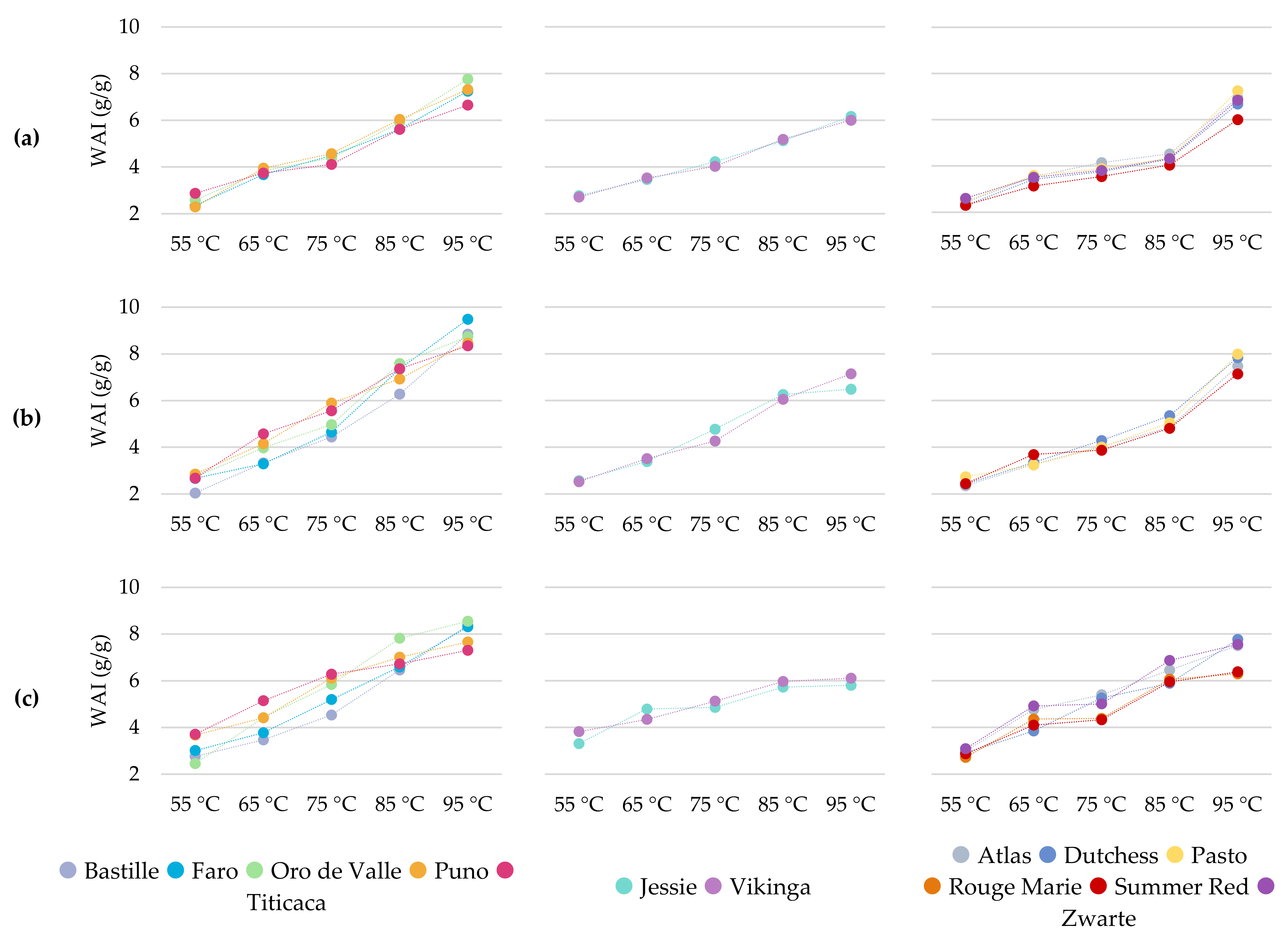

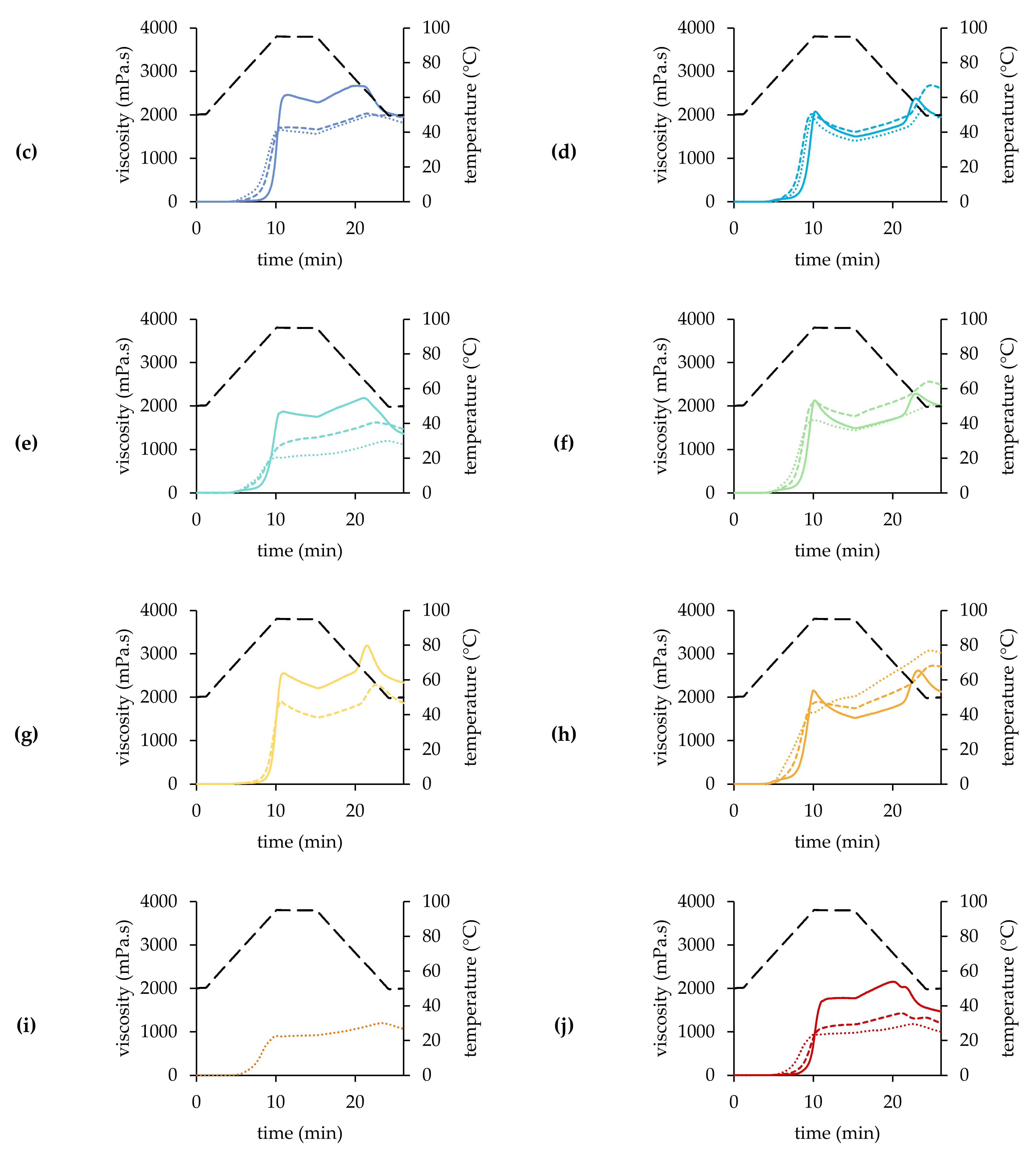
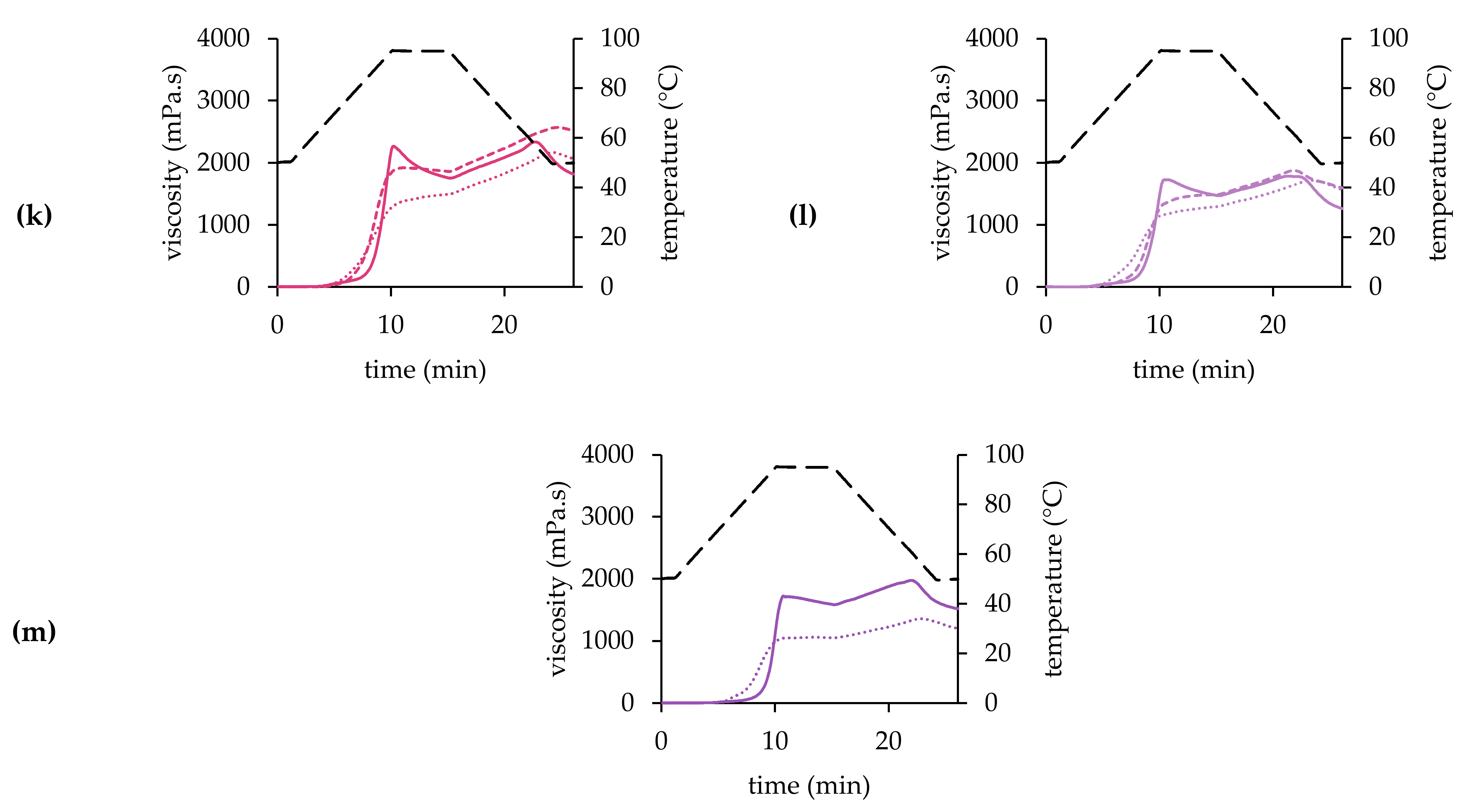
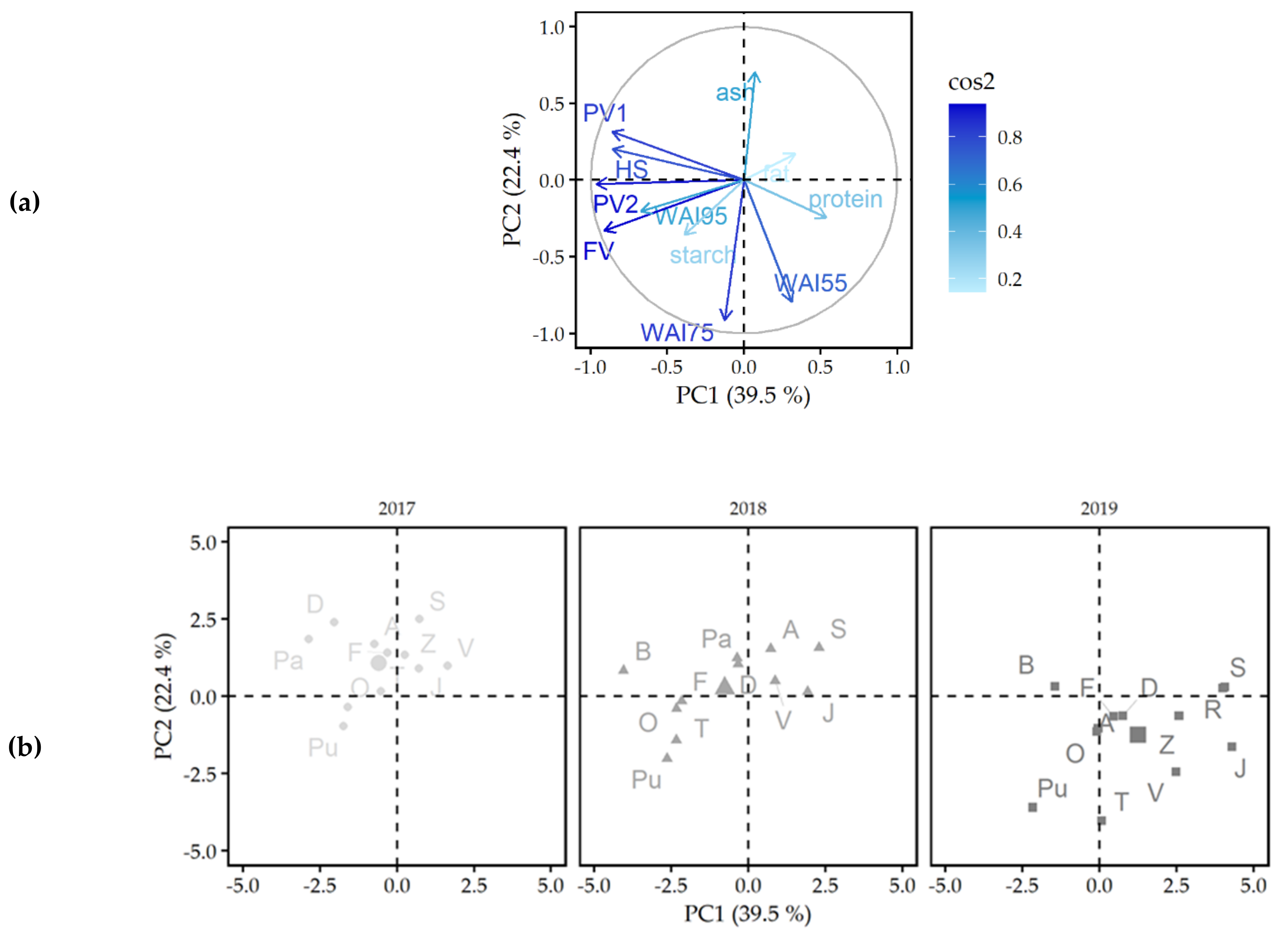
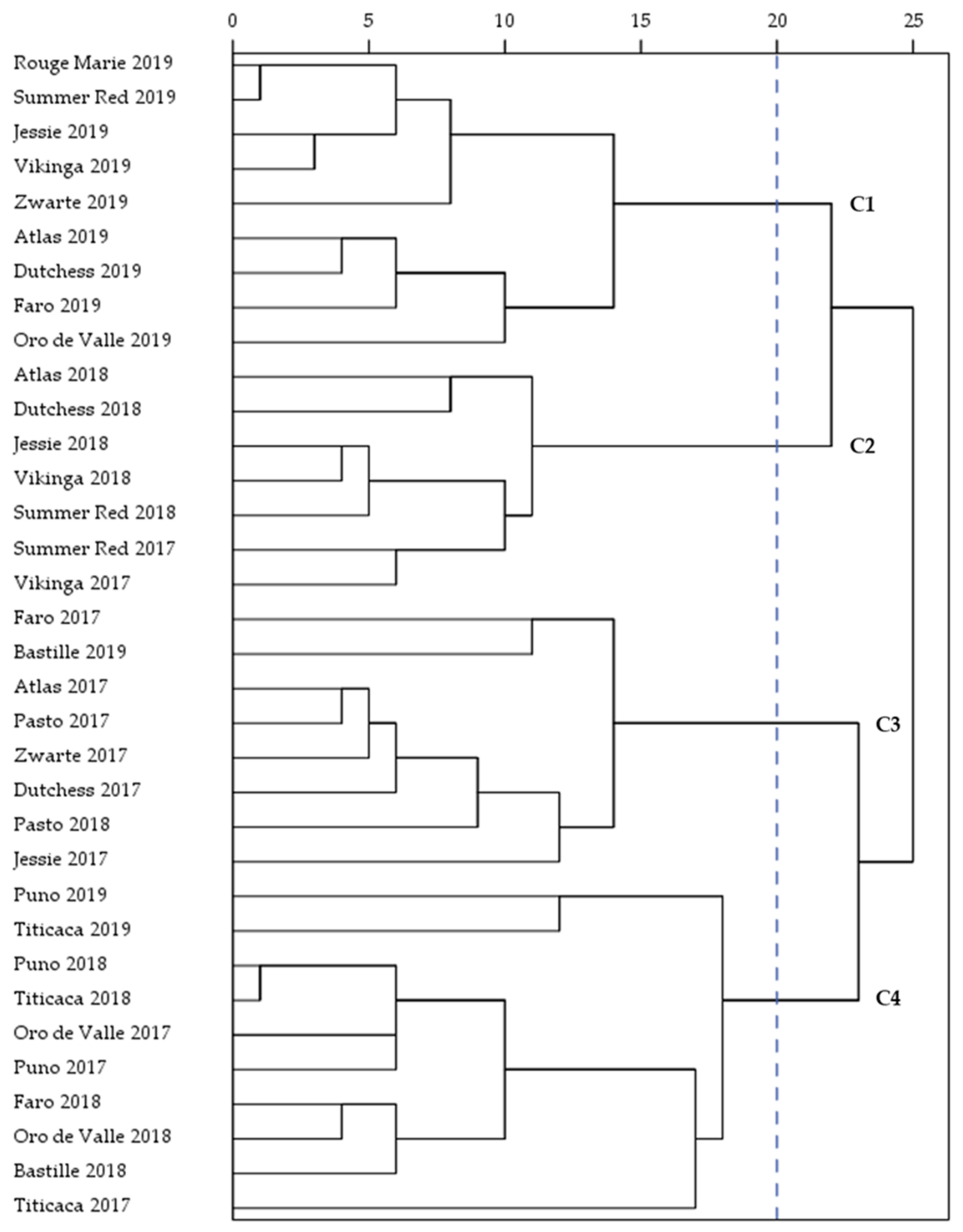
| Year | Variety | Protein (g/100 g dm) 1 | Fat (g/100 g dm) 1 | Starch (g/100 g dm) 1 | Ash (g/100 g dm) 1 |
|---|---|---|---|---|---|
| 2017 | Atlas | 16.6 ± 0.2 fA | 6.41 ± 0.04 cA | 58.1 ± 0.6 dB | 3.46 ± 0.02 gC |
| Bastille | − | − | − | − | |
| Dutchess | 13.8 ± 0.0 cA | 7.03 ± 0.07 eA | 59.6 ± 0.5 eB | 3.35 ± 0.01 fB | |
| Faro | 14.9 ± 0.3 dB | 7.33 ± 0.09 fA | 53.4 ± 0.7 aB | 3.32 ± 0.02 efB | |
| Jessie | 16.0 ± 0.2 eB | 6.70 ± 0.04 dA | 54.9 ± 0.7 bA | 3.12 ± 0.02 dC | |
| Oro de Valle | 12.1 ± 0.2 aA | 6.18 ± 0.03 cA | 67.2 ± 1.2 gC | 2.86 ± 0.03 bA | |
| Pasto | 15.5 ± 0.3 eA | 5.42 ± 0.05 aA | 56.5 ± 0.5 cA | 3.47 ± 0.02 gA | |
| Puno | 13.9 ± 0.2 cB | 5.65 ± 0.02 abA | 61.7 ± 0.4 fB | 2.37 ± 0.02 aA | |
| Rouge Marie | − | − | − | − | |
| Summer Red | 13.9 ± 0.2 cB | 8.54 ± 0.08 iC | 58.0 ± 0.2 dC | 3.29 ± 0.01 eB | |
| Titicaca | 14.8 ± 0.1 dB | 7.61 ± 0.08 gB | 60.7 ± 0.8 fA | 2.84 ± 0.01 bAB | |
| Vikinga | 14.9 ± 0.4 dB | 8.04 ± 0.08 hB | 57.8 ± 0.7 dA | 3.02 ± 0.03 cB | |
| Zwarte | 13.0 ± 0.3 bA | 5.70 ± 0.03 bA | 55.2 ± 0.7 bA | 3.16 ± 0.03 dA | |
| 2018 | Atlas | 16.4 ± 0.1 fA | 7.78 ± 0.03 eC | 57.5 ± 0.5 aB | 3.30 ± 0.02 cB |
| Bastille | 13.1 ± 0.2 bA | 7.34 ± 0.01 dA | 64.0 ± 0.3 eB | 3.09 ± 0.03 bB | |
| Dutchess | 14.4 ± 0.2 eB | 7.75 ± 0.04 eB | 61.4 ± 0.4 cC | 3.32 ± 0.02 cB | |
| Faro | 13.2 ± 0.2 bA | 8.09 ± 0.08 fC | 58.2 ± 0.4 abC | 3.07 ± 0.01 bA | |
| Jessie | 13.7 ± 0.1 cdA | 7.93 ± 0.05 efB | 59.1 ± 0.4 bC | 3.08 ± 0.01 bB | |
| Oro de Valle | 12.2 ± 0.1 aA | 7.73 ± 0.06 eC | 62.5 ± 0.6 dB | 3.08 ± 0.01 bC | |
| Pasto | 16.0 ± 0.2 fB | 6.37 ± 0.04 aB | 59.0 ± 0.6 bB | 3.60 ± 0.02 dB | |
| Puno | 12.5 ± 0.2 aA | 6.67 ± 0.03 bC | 63.7 ± 0.3 eC | 2.90 ± 0.02 aC | |
| Rouge Marie | − | − | − | − | |
| Summer Red | 13.3 ± 0.1 bcA | 8.18 ± 0.01 fB | 57.3 ± 0.3 aB | 3.27 ± 0.03 cB | |
| Titicaca | 13.2 ± 0.1 bA | 7.08 ± 0.03 cA | 63.9 ± 0.7 eB | 2.88 ± 0.01 aB | |
| Vikinga | 13.8 ± 0.4 dA | 8.50 ± 0.09 gC | 63.6 ± 0.2 eC | 3.08 ± 0.03 bC | |
| Zwarte | − | − | − | − | |
| 2019 | Atlas | 18.5 ± 0.0 fgB | 7.20 ± 0.14 dB | 54.5 ± 0.4 cA | 3.03 ± 0.02 cdA |
| Bastille | 16.6 ± 0.0 bcB | 7.36 ± 0.19 deA | 52.3 ± 0.5 bA | 3.01 ± 0.03 cdA | |
| Dutchess | 18.4 ± 0.1 fgC | 7.17 ± 0.04 dA | 54.8 ± 0.2 cdA | 3.21 ± 0.01 fA | |
| Faro | 17.6 ± 0.1 dC | 7.61 ± 0.12 efB | 50.5 ± 0.4 aA | 3.09 ± 0.01 deA | |
| Jessie | 18.8 ± 0.0 gC | 6.70 ± 0.24 cA | 55.6 ± 1.3 deB | 2.84 ± 0.03 aC | |
| Oro de Valle | 16.2 ± 0.0 abB | 7.22 ± 0.07 dB | 54.7 ± 0.8 cdA | 2.91 ± 0.02 bB | |
| Pasto | − | − | − | − | |
| Puno | 17.0 ± 0.1 cC | 5.88 ± 0.24 aB | 59.4 ± 1.1 fA | 2.83 ± 0.01 aB | |
| Rouge Marie | 17.8 ± 0.1 deA | 7.65 ± 0.08 fA | 53.9 ± 0.2 cA | 3.10 ± 0.02 eA | |
| Summer Red | 18.1 ± 0.2 efC | 7.75 ± 0.09 fA | 54.5 ± 0.4 cA | 3.20 ± 0.01 fA | |
| Titicaca | 16.0 ± 0.1 aC | 7.25 ± 0.03 dA | 72.5 ± 0.9 hC | 2.83 ± 0.02 aA | |
| Vikinga | 17.0 ± 0.1 cC | 7.71 ± 0.04 fA | 60.8 ± 0.5 gB | 2.82 ± 0.02 aA | |
| Zwarte | 16.0 ± 0.1 aB | 6.36 ± 0.08 bB | 56.2 ± 0.2 eB | 3.29 ± 0.04 gB |
Publisher’s Note: MDPI stays neutral with regard to jurisdictional claims in published maps and institutional affiliations. |
© 2022 by the authors. Licensee MDPI, Basel, Switzerland. This article is an open access article distributed under the terms and conditions of the Creative Commons Attribution (CC BY) license (https://creativecommons.org/licenses/by/4.0/).
Share and Cite
De Bock, P.; Cnops, G.; Muylle, H.; Quataert, P.; Eeckhout, M.; Van Bockstaele, F. Physicochemical Characterization of Thirteen Quinoa (Chenopodium quinoa Willd.) Varieties Grown in North-West Europe—Part II. Plants 2022, 11, 265. https://doi.org/10.3390/plants11030265
De Bock P, Cnops G, Muylle H, Quataert P, Eeckhout M, Van Bockstaele F. Physicochemical Characterization of Thirteen Quinoa (Chenopodium quinoa Willd.) Varieties Grown in North-West Europe—Part II. Plants. 2022; 11(3):265. https://doi.org/10.3390/plants11030265
Chicago/Turabian StyleDe Bock, Phara, Gerda Cnops, Hilde Muylle, Paul Quataert, Mia Eeckhout, and Filip Van Bockstaele. 2022. "Physicochemical Characterization of Thirteen Quinoa (Chenopodium quinoa Willd.) Varieties Grown in North-West Europe—Part II" Plants 11, no. 3: 265. https://doi.org/10.3390/plants11030265
APA StyleDe Bock, P., Cnops, G., Muylle, H., Quataert, P., Eeckhout, M., & Van Bockstaele, F. (2022). Physicochemical Characterization of Thirteen Quinoa (Chenopodium quinoa Willd.) Varieties Grown in North-West Europe—Part II. Plants, 11(3), 265. https://doi.org/10.3390/plants11030265







